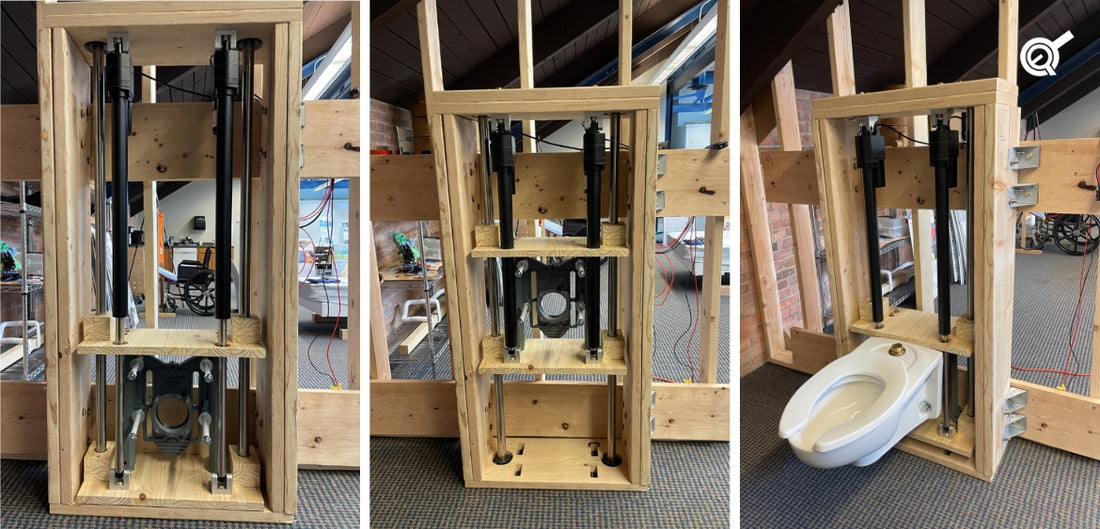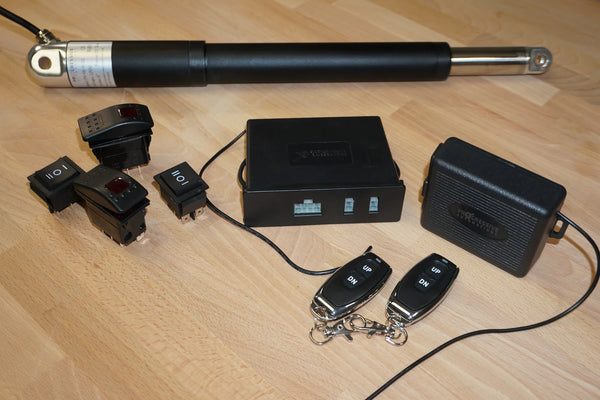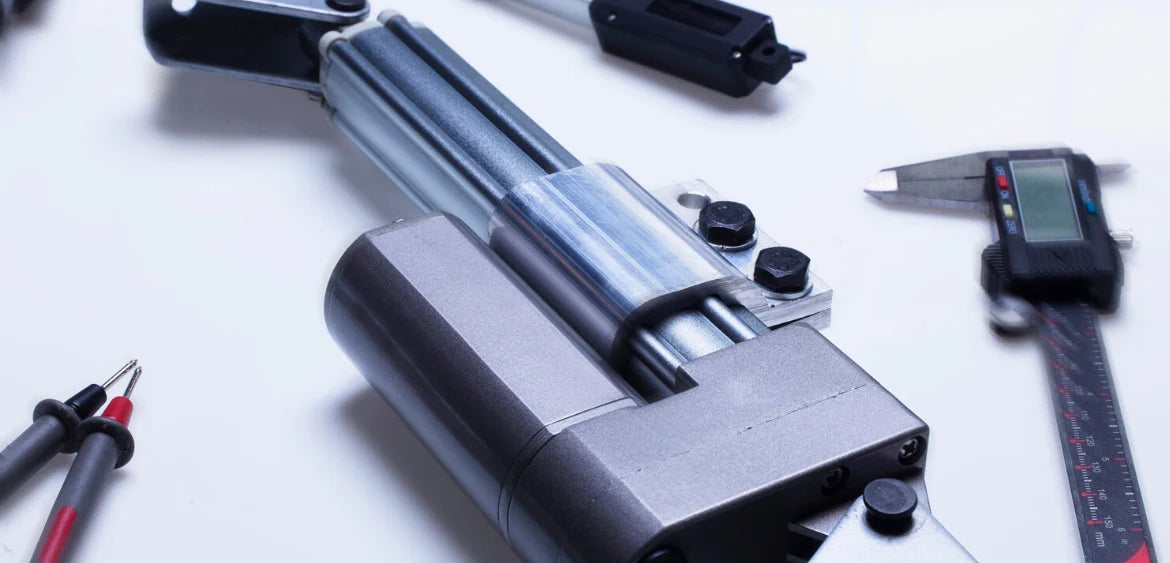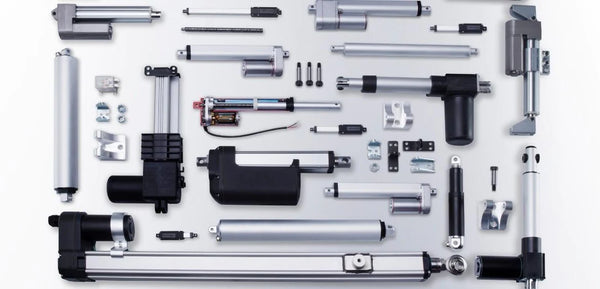Using the bathroom is a common part of everyone’s day, however, users with mobility limitations, injuries, or disabilities may find the standard bathroom challenging to use. At most, standard bathrooms may occasionally come with railings or wider stalls, however, these are still not a complete solution for all users with mobility issues. The toilet height adjustability and accessibility are specific areas that larger public settings could improve on. These solutions exist today; however, they are mainly used in home private settings and are not affordable for practical use in public settings. In this article, we cover the RIT MSD Universal Lavatory Test Stand Team’s journey for making affordable, fast, and easy drop-in solutions for adjustable toilets that can help individuals with mobility challenges.
Team Introduction
Also known as “A Toilet in Motion!”, the Universal Lavatory Test Stand is a team project by students from the Rochester Institute of Technology in various engineering fields:
Robert Cho – Mechanical and Systems Engineer
Aubrey Figoras – Mechanical Engineer and CAD Designer
Chloe Cattadoris – Industrial Engineer and Project Manager
John Lowenhaupt – Electrical Engineer and Facilitator
Zach Flickinger – Electrical and Systems Engineer
Manny Pizarro – Mechanical Engineer and Purchaser
The original prompt for the project was brought forth by Daniel Phillips and Stan Rickel of the RIT LiveAbility Lab, who were seeking to create an accessible lavatory that could accommodate users with mobility issues. The goal was to develop a moveable toilet that would adhere to ADA standards when in a home position but could also be adjusted (both manually and automatically) in height to suit any user's needs. Through the guidance of the RIT Multidisciplinary Senior Design program, the team spent the first semester identifying customer requirements, benchmarking existing products, and developing a preliminary system design.
Planning and Designing the System

The mechanical system was designed using SolidWorks while the electrical schematics were designed using Altium. As the base of the mechanical design, they chose to use the Watts ISCA-101-R IS Cast Iron Single Closet Carrier, which could support an American Standard wall-mounted toilet and was rated for a capacity of 500 lbs. The total estimated load included the 77 lbs toilet carrier, approximately 50 lbs for the toilet, and up to 350 lbs to accommodate a 99th percentile human.
Because the load was cantilevered, the design required guide rails to help counter the induced moment. A stress analysis performed by the team helped to determine that two guide rails made of 1-1/2" diameter 1566 carbon steel would be sufficient for supporting the load without yielding due to bending or fatigue.
Cutting Out the Wooden Pieces
Most of the build was completed at The Construct maker space located on the RIT campus dedicated to supporting RIT students in personal and class projects. All wooden parts surrounding the toilet carrier, as well as the header and footer of the frame, were manufactured on a ShopSabre CNC Router, due to the precision and complexity of the holes they required.
The team designed a set of wooden planks that the toilet carrier could be mounted to. These wooden planks also had to encompass four heavy-duty linear ball bearings to ride the guide rails and provide an area for actuators to be mounted. The material selected for this was a 1" thick pine board from Lowe's. Using a CNC router, the team was able to cut a 1" thick pine project panel into the required parts for the toilet carrier system.

Framing for the system was made of 2x12 dimensional lumber, with the side studs of the frame doubled up for extra strength. As part of this frame, the team designed a custom header and footer to which the guide rails would be mounted. These CNC'd parts for the bottom and top of the Universal Lavatory Test Stand frame are seen in the picture below where the top piece is the frame header from which the linear actuators will be mounted.

Choosing Suitable Linear Actuators
For this project, linear actuators were carefully selected based on three main factors:
- travel speed
- dynamic load capacity
- stroke length
The team needed a speed that was relatively fast, but also safe for human use, and a motion range of approximately 24". After lots of research, they found the PA-17-24-850 to be the best option to suit their requirements. Though one actuator would have been perfectly capable of supporting the entire load of 500 lbs, two actuators were chosen to be used for redundancy.

The Assembly Process
Once all the parts were manufactured and cut to appropriate lengths, the team assembled the toilet carrier system. By pressing the bearings into the wooden planks and screwing together the bearing adapters, the team could get their bearings "trapped" within the CNC-routed planks.

The rest of the frame was cut using a radial arm saw and assembled with a hand drill and screws. Any additional assembly was completed using 1/2" diameter bolts, nylock nuts, and socket wrenches.
Next, a COTS (commercial-off-the-shelf) toilet carrier was secured between the two CNC'd wooden planks to form an assembled toilet carrier system.

From here, the linear guide rails were pushed through the bearings and had flanges attached to each end. The team then assembled the frame around the toilet carrier, with the guide rail flanges mounted into the header and footer of the frame. Once this step was finished on the floor, they were able to stand the entire system up and mount it to the wall with steel angle brackets and BRK-17 mounting brackets.

The two PA-17 actuators were installed last by attaching their mounting holes to the mounting brackets on the frame header, extending them to their full length, and attaching them to the base of the toilet carrier system. After thoroughly discussing with the team’s professor and mentor from the RIT Multidisciplinary Senior Design program, other electronics besides the rocker switch were considered unnecessary to install due to the final decision to not implement the originally planned control system. The assembled Universal Lavatory Test Stand, now with PA-17 actuators wired to a rocker switch can be seen below.

Final Tests and Results
In the end, the team couldn’t implement the AC-26-30 speed controllers in time as they misunderstood how speed controllers worked. Previously, the team attempted operating these speed controllers with their switching devices on the input side, however, the switching devices need to be on the output side to work correctly. Because of this, their speed controllers worked perfectly in 1 direction, but reversing the polarity didn't work. With not enough time to troubleshoot and redesign the system, the team had to leave this feature out and work with a single rocker switch for user control.
Time constraints also resulted in the electrical system containing the Arduino Uno and RFID for preset heights not being implemented into the system and were left as completely theoretical work for now. The team was successfully able to carry out weight and motion testing of the completed Universal Lavatory Test Stand with 350 lbs of applied load to verify proper operation.

IN SUMMARY
Despite challenges such as lacking sufficient funding, topical knowledge, and industry experience, the RIT MSD Universal Lavatory Test Stand Team was still able to complete their project assembly in the end. The team is also grateful for having the opportunity to bring the ideas of LiveAbility Lab to life and thanks Mark Minunni for all his project guidance and real-life advice for their future.
Thank you to the RIT MSD Universal Lavatory Test Stand Team for sharing your project and showcasing how important time and money truly are to real-world projects! To see more from the Rochester Institute of Technology, feel free to check them out on Youtube, Facebook, and Instagram! If you have any queries about our electric linear actuators or wish to discuss our other products further, please do not hesitate in reaching out to us! We are experts in what we do and will be happy to assist in any way we can.
sales@progressiveautomations.com | 1-800-676-6123








